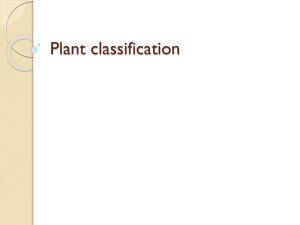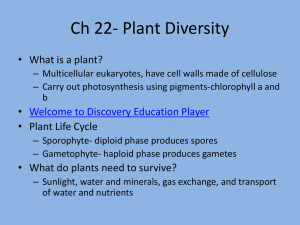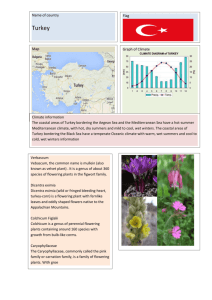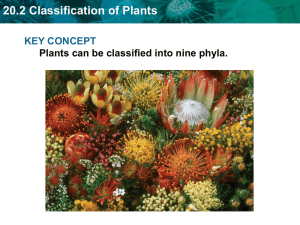Plant Study Guide Vocabulary: Plant Cuticle Stomata Vascular
advertisement
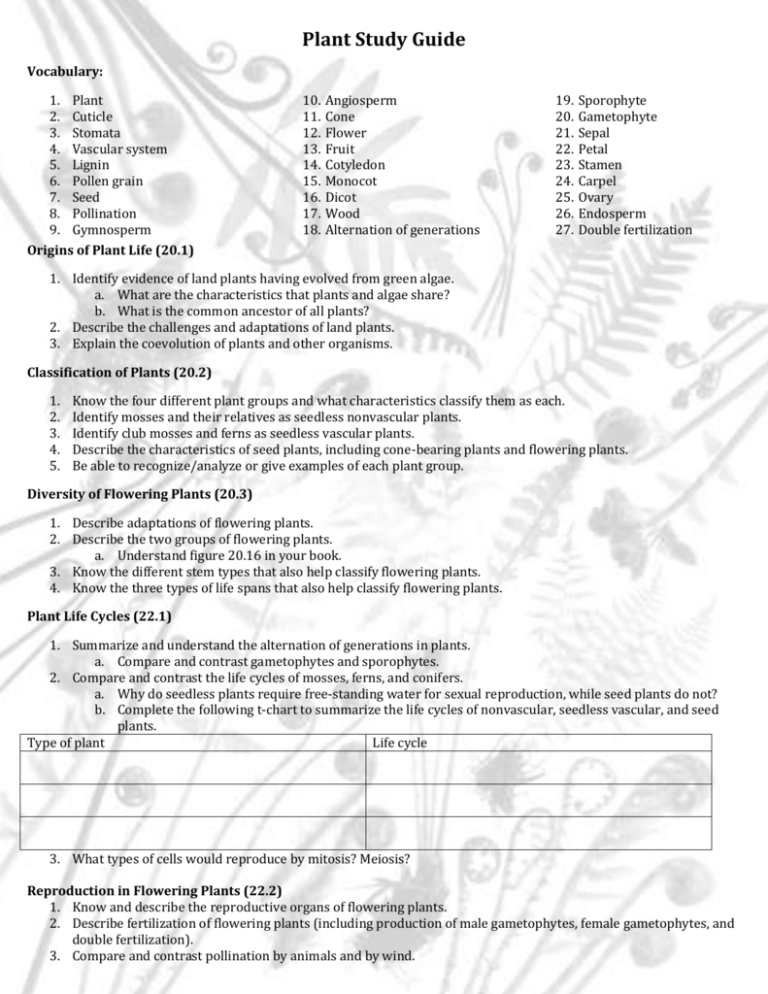
Plant Study Guide Vocabulary: 1. Plant 2. Cuticle 3. Stomata 4. Vascular system 5. Lignin 6. Pollen grain 7. Seed 8. Pollination 9. Gymnosperm Origins of Plant Life (20.1) 10. 11. 12. 13. 14. 15. 16. 17. 18. Angiosperm Cone Flower Fruit Cotyledon Monocot Dicot Wood Alternation of generations 19. 20. 21. 22. 23. 24. 25. 26. 27. Sporophyte Gametophyte Sepal Petal Stamen Carpel Ovary Endosperm Double fertilization 1. Identify evidence of land plants having evolved from green algae. a. What are the characteristics that plants and algae share? b. What is the common ancestor of all plants? 2. Describe the challenges and adaptations of land plants. 3. Explain the coevolution of plants and other organisms. Classification of Plants (20.2) 1. 2. 3. 4. 5. Know the four different plant groups and what characteristics classify them as each. Identify mosses and their relatives as seedless nonvascular plants. Identify club mosses and ferns as seedless vascular plants. Describe the characteristics of seed plants, including cone-bearing plants and flowering plants. Be able to recognize/analyze or give examples of each plant group. Diversity of Flowering Plants (20.3) 1. Describe adaptations of flowering plants. 2. Describe the two groups of flowering plants. a. Understand figure 20.16 in your book. 3. Know the different stem types that also help classify flowering plants. 4. Know the three types of life spans that also help classify flowering plants. Plant Life Cycles (22.1) 1. Summarize and understand the alternation of generations in plants. a. Compare and contrast gametophytes and sporophytes. 2. Compare and contrast the life cycles of mosses, ferns, and conifers. a. Why do seedless plants require free-standing water for sexual reproduction, while seed plants do not? b. Complete the following t-chart to summarize the life cycles of nonvascular, seedless vascular, and seed plants. Type of plant Life cycle 3. What types of cells would reproduce by mitosis? Meiosis? Reproduction in Flowering Plants (22.2) 1. Know and describe the reproductive organs of flowering plants. 2. Describe fertilization of flowering plants (including production of male gametophytes, female gametophytes, and double fertilization). 3. Compare and contrast pollination by animals and by wind. Plant Study Guide Vocabulary: 28. Plant 29. Cuticle 30. Stomata 31. Vascular system 32. Lignin 33. Pollen grain 34. Seed 35. Pollination 36. Gymnosperm Origins of Plant Life (20.1) 37. 38. 39. 40. 41. 42. 43. 44. 45. Angiosperm Cone Flower Fruit Cotyledon Monocot Dicot Wood Alternation of generations 46. 47. 48. 49. 50. 51. 52. 53. 54. Sporophyte Gametophyte Sepal Petal Stamen Carpel Ovary Endosperm Double fertilization 4. Identify evidence of land plants having evolved from green algae. a. What are the characteristics that plants and algae share? b. What is the common ancestor of all plants? 5. Describe the challenges and adaptations of land plants. 6. Explain the coevolution of plants and other organisms. Classification of Plants (20.2) 6. 7. 8. 9. 10. Know the four different plant groups and what characteristics classify them as each. Identify mosses and their relatives as seedless nonvascular plants. Identify club mosses and ferns as seedless vascular plants. Describe the characteristics of seed plants, including cone-bearing plants and flowering plants. Be able to recognize/analyze or give examples of each plant group. Diversity of Flowering Plants (20.3) 5. Describe adaptations of flowering plants. 6. Describe the two groups of flowering plants. a. Understand figure 20.16 in your book. 7. Know the different stem types that also help classify flowering plants. 8. Know the three types of life spans that also help classify flowering plants. Plant Life Cycles (22.1) 4. Summarize and understand the alternation of generations in plants. a. Compare and contrast gametophytes and sporophytes. 5. Compare and contrast the life cycles of mosses, ferns, and conifers. a. Why do seedless plants require free-standing water for sexual reproduction, while seed plants do not? b. Complete the following t-chart to summarize the life cycles of nonvascular, seedless vascular, and seed plants. Type of plant Life cycle 6. What types of cells would reproduce by mitosis? Meiosis? Reproduction in Flowering Plants (22.2) 4. Know and describe the reproductive organs of flowering plants. 5. Describe fertilization of flowering plants (including production of male gametophytes, female gametophytes, and double fertilization). 6. Compare and contrast pollination by animals and by wind.




